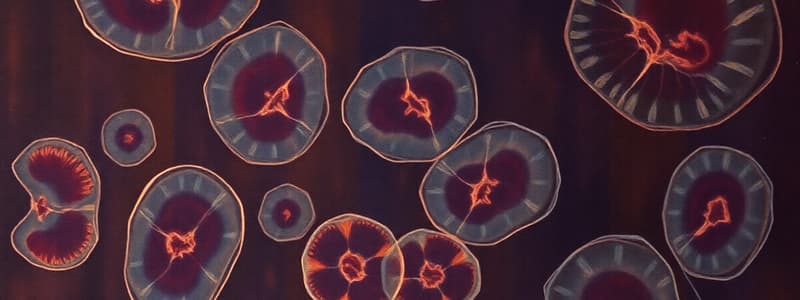Podcast
Questions and Answers
Compare and contrast the main structural differences between prokaryotic and eukaryotic cells, focusing on the presence or absence of membrane-bound organelles.
Compare and contrast the main structural differences between prokaryotic and eukaryotic cells, focusing on the presence or absence of membrane-bound organelles.
Prokaryotic cells lack membrane-bound organelles like a nucleus, while eukaryotic cells possess them. Prokaryotes have a simpler structure with DNA in a nucleoid region, whereas eukaryotes have a complex structure with DNA enclosed in a nucleus.
Explain the significance of the surface area to volume ratio in the context of cell size and function. How does this ratio limit cell size?
Explain the significance of the surface area to volume ratio in the context of cell size and function. How does this ratio limit cell size?
As a cell increases in size, the surface area to volume ratio decreases. A lower ratio limits the rate at which substances can cross the membrane to supply the volume of the cell which also affects how quickly waste can be removed.
Describe the endosymbiotic theory and provide two pieces of evidence that support the idea that mitochondria and chloroplasts were once independent prokaryotic cells.
Describe the endosymbiotic theory and provide two pieces of evidence that support the idea that mitochondria and chloroplasts were once independent prokaryotic cells.
The endosymbiotic theory suggests that mitochondria and chloroplasts were once free-living prokaryotes that were engulfed by a larger cell. Evidence includes their own DNA/ genetic material (circular DNA) and double membranes.
Outline the function of the following cell structures: ribosomes, endoplasmic reticulum (ER), Golgi apparatus, and lysosomes, and explain how they work together in protein production and processing.
Outline the function of the following cell structures: ribosomes, endoplasmic reticulum (ER), Golgi apparatus, and lysosomes, and explain how they work together in protein production and processing.
Compare and contrast the structures and functions of plant and animal cells, highlighting the unique features of each, such as cell walls in plant cells and centrioles in animal cells.
Compare and contrast the structures and functions of plant and animal cells, highlighting the unique features of each, such as cell walls in plant cells and centrioles in animal cells.
Briefly explain how the arrangement of phospholipids in a cell membrane contributes to its selective permeability.
Briefly explain how the arrangement of phospholipids in a cell membrane contributes to its selective permeability.
Differentiate between simple diffusion, facilitated diffusion, and active transport, including the role of membrane proteins and energy (ATP) in each process.
Differentiate between simple diffusion, facilitated diffusion, and active transport, including the role of membrane proteins and energy (ATP) in each process.
Describe the processes of endocytosis and exocytosis, and explain how they enable cells to transport large molecules or particles across the plasma membrane.
Describe the processes of endocytosis and exocytosis, and explain how they enable cells to transport large molecules or particles across the plasma membrane.
Explain the importance of water potential in plant cells, and how it affects turgor pressure and plasmolysis.
Explain the importance of water potential in plant cells, and how it affects turgor pressure and plasmolysis.
Describe how the sodium-potassium pump works and its significance in maintaining the resting membrane potential in nerve cells.
Describe how the sodium-potassium pump works and its significance in maintaining the resting membrane potential in nerve cells.
Define the term 'stem cell' and explain the difference between totipotent, pluripotent, and multipotent stem cells.
Define the term 'stem cell' and explain the difference between totipotent, pluripotent, and multipotent stem cells.
List three specific examples of specialized cells in the human body and describe how their structure relates to their function.
List three specific examples of specialized cells in the human body and describe how their structure relates to their function.
Explain the role of cholesterol in the cell membrane and the effect it has on membrane fluidity at different temperatures.
Explain the role of cholesterol in the cell membrane and the effect it has on membrane fluidity at different temperatures.
Describe the extracellular matrix (ECM) and the function it performs in animal tissues.
Describe the extracellular matrix (ECM) and the function it performs in animal tissues.
Outline the role of the nuclear envelope and nuclear pores in regulating the transport of molecules between the nucleus and the cytoplasm.
Outline the role of the nuclear envelope and nuclear pores in regulating the transport of molecules between the nucleus and the cytoplasm.
Describe the function of aquaporins and explain why they are important for water transport across cell membranes.
Describe the function of aquaporins and explain why they are important for water transport across cell membranes.
Explain the process of receptor-mediated endocytosis and its importance in selectively importing specific molecules into the cell.
Explain the process of receptor-mediated endocytosis and its importance in selectively importing specific molecules into the cell.
Compare and contrast the roles of microfilaments, intermediate filaments, and microtubules in the cytoskeleton.
Compare and contrast the roles of microfilaments, intermediate filaments, and microtubules in the cytoskeleton.
Describe how cell junctions (tight junctions, adherens junctions, desmosomes, gap junctions) enable cells to interact and communicate in tissues.
Describe how cell junctions (tight junctions, adherens junctions, desmosomes, gap junctions) enable cells to interact and communicate in tissues.
Explain the role of the cell wall in bacterial cells and describe how it differs from the cell wall in plant cells.
Explain the role of the cell wall in bacterial cells and describe how it differs from the cell wall in plant cells.
Flashcards
Main cell types
Main cell types
Prokaryotic and eukaryotic cells are the two basic types of cells. Prokaryotes lack a nucleus and other membrane-bound organelles, while eukaryotes possess these features.
Stem Cell
Stem Cell
Stem cells are undifferentiated cells that can differentiate into specialised cells. They are important for growth, repair, and renewal in tissues.
Cell membrane function
Cell membrane function
Cell membranes control the movement of substances in and out of cells. They are selectively permeable, allowing some molecules to pass through while blocking others.
Cellular transport
Cellular transport
Signup and view all the flashcards
Key cell structures
Key cell structures
Signup and view all the flashcards
Study Notes
- BioNinja is a resource for IB Biology students.
- The site covers various topics including Biomolecules, Cells, Metabolism, Genetics, Heredity, Equilibrium, and Body, Plant systems.
- Other topics covered include Biodiversity, Nutrition, Ecology, and Human Impacts.
- Themes included are Unity and Diversity, Form and Function, Interdependencies, and Continuity/Change.
- Resources for review include PowerPoints, topic notes, summaries, and worksheets.
- There are resources for both standard and higher level students.
- The cells section also covers introduction to cells, cell types, specialisation, membranes, transport and origins of cells.
- Also included are cell structures and cell membranes for HL students.
Studying That Suits You
Use AI to generate personalized quizzes and flashcards to suit your learning preferences.




